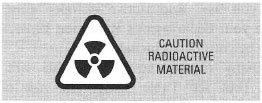Working practices when using radioactive isotopes
By law, undergraduate work with radioactive isotopes must be very closely supervised. In practical classes, the protocols will be clearly outlined, but in project work you may have the opportunity to plan and carry out your own experiments, albeit under supervision. Some of the factors that you should take into account, based on the assumption that your department and laboratory are registered for radioisotope use, are discussed below:- Must you use radioactivity? If not, it may be a legal requirement that you use the alternative method.
- Have you registered for radioactive work? Normal practice is for all users to register with a local Radiation Protection Supervisor. Details of the project may have to be approved by the appropriate administrator(s). You may have to have a short medical examination before you can start work.
- What labelled compound will you use? Radioactive isotopes must be
ordered well in advance through your department's Radiation Protection
Supervisor. Aspects that need to be considered include:
- The radionuclide. With many organic compounds this will be confined to 3H and 14C (but see Table 35.2). The risk of a significant 'isotope effect' may influence this decision (see above).
- The labelling position. This may be a crucial part of a metabolic study. Specifically labelled compounds are normally more expensive than those that are uniformly ('generally') labelled.
- The specific activity. The upper limit for this is defined by the isotope's half-life, but below this the higher the specific activity, the more expensive the compound.
- Are suitable facilities available? You will need a suitable work area, preferably out of the way of general lab traffic and within a fume cupboard for those cases where volatile radioactive substances are used or may be produced.
Safety and procedural aspects
Make sure the bench surface is one that can be easily decontaminated by washing (e.g. Formica®) and always use a disposable surfacing material such as Benchkote®. It is good practice to carry out as many operations as possible within a Benchkote®-lined plastic tray so that any spillages are contained. You will need a lab coat to be used exclusively for work with radioactivity, safety spectacles and a supply of thin latex or vinyl disposable gloves.
 |
| Fig. 35.3 Tape showing the international symbol for radioactivity. |
It is important to comply with the following guidelines:
- Read and obey the local rules for safe usage of radiochemicals.
- Maximize the distance between you and the source as much as possible.
- Minimize the duration of exposure.
- Wear protective clothing (properly fastened lab coat, safety glasses, gloves) at all times.
- Use appropriate shielding at all times (Table 35.1).
- Monitor your working area frequently for contamination.
- Mark all glassware, trays, bench work areas, etc., with tape incorporating the international symbol for radioactivity (Fig. 35.3).
- Keep adequate records of what you have done with a radioisotope - the stock remaining and that disposed of in waste form must agree.
- Store radiolabelled compounds appropriately and return them to storage areas immediately after use.
- Dispose of waste promptly and with due regard for local rules.
- Make the necessary reports about waste disposal etc. to your departmental Radiation Protection Supervisor.
- Clear up after you have finished each experiment.
- Wash thoroughly after using radioactivity.
- Monitor the work area and your body when finished.




